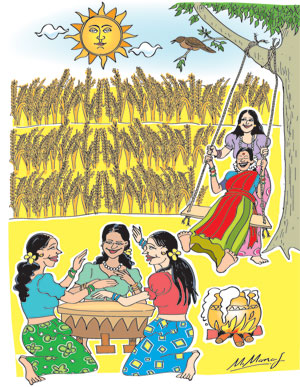Columns
A bumper paddy harvest brightens the New Year
View(s): Today is a day of celebration. It is a day when presents are exchanged, sweetmeats are prepared and games are played while raban playing captures the joyful mood of the people. It is a time to rejoice as a bountiful harvest is reaped after three consecutive years. It is a time when economic difficulties are forgotten.
Today is a day of celebration. It is a day when presents are exchanged, sweetmeats are prepared and games are played while raban playing captures the joyful mood of the people. It is a time to rejoice as a bountiful harvest is reaped after three consecutive years. It is a time when economic difficulties are forgotten.
Harvest celebration
The national New Year is essentially the celebration of the harvest and a rural-centric festival. People from the cities flock to their rural roots to celebrate reunion with their families. Animosities are forgotten as the New Year dawns. It is time of social harmony and socialising with relatives, friends and neighbours.
High spirits
Despite the exhortation of the President, alcohol consumption will be at a peak during the festivities this week. Illicit liquor consumption would be higher because of the Government’s high taxation of alcoholic beverages of the poor. Illicit brews that are affordable to the poor will be consumed in larger measure.
Reason to celebrate
In spite of the economy’s slow progress, rural Sri Lanka has reasons to celebrate. The bad weather that afflicted the country for three years ended and last year’s Yala harvest and this year’s Maha harvest are bumper ones.
This year’s festivities are in the backdrop of this bumper Maha rice crop, which was preceded by a good Yala crop last year. This year’s national New Year is brightened by the record Maha bumper paddy harvest. This is certainly good reason for rural Sri Lanka and the nation as a whole to celebrate.
Paddy production
 The Maha 2018-19 paddy crop is estimated at 3.3 million metric tonnes. It is the highest ever Maha paddy harvest surpassing by 27 percent the previous highest production of 2.4 million metric tonnes in 2014. This is a significant achievement to celebrate during this year’s New Year.
The Maha 2018-19 paddy crop is estimated at 3.3 million metric tonnes. It is the highest ever Maha paddy harvest surpassing by 27 percent the previous highest production of 2.4 million metric tonnes in 2014. This is a significant achievement to celebrate during this year’s New Year.
Maha crop
The country’s rice production has been improving with normalisation of weather since the end of last year. The 2018/19 Maha crop is a 40.2 percent increase from that of the last Maha (2017-18). Prior to that, paddy production decreased in six consecutive seasons due to adverse weather conditions. The highest previous Maha harvest was of 2.7 million tons in 2015.
It must be the hope of all that the monsoon rains would pour down to enable this year’s Yala cultivation and fill the reservoirs to generate hydroelectricity at its maximum capacity.
Yala
The 2018 Yala harvest of 1.9 million metric tons and the estimated Maha paddy crop of over 3 million tons is more than double the last harvest. It is the highest ever paddy harvest. The bumper Maha harvest that comes on top of a bumper Yala harvest means that the country is self-sufficient in rice this year.
The Maha crop of 3.3 million metric tonnes alone would feed the nation for 10 months. Then the Yala crop should be able to meet the requirements of the remaining two months. In fact, there may be a surplus that could enhance the country’s rice stocks.
Depressed prices
This good news has a tinge of disappointment, though. The benefits of the increased rice crop have not been reaped by the farmers owing to the depressed prices. Part of this fall in price is inevitable owing to the iron law in economics that when supply increases with no commensurate increase in demand, price falls.
However the depressed prices are also owing to the monopolistic grip on the market by rice millers and the ineffective implementation of the government’s programme of purchasing paddy at the announced guaranteed price. Inefficiencies, corruption and the powerful vested interests of millers, especially in the North Central Province, and particularly in Polonnaruwa, account for the low prices to farmers.
The Government has admitted the incapacity of the Paddy Marketing Board (PMB) to purchase the paddy and is adopting alternative means for buying paddy ay guaranteed prices. District Secretariats have been asked to purchase the paddy at the guaranteed prices. Hopefully this will alleviate the plight of the farmers.
Perennial problem
The inability of the Government to purchase adequate quantities of paddy at the guaranteed price has been a perennial problem. Despite many budget proposals to increase storage capacity and resolve this problem, there has hardly been any progress. Increased harvests depress prices and increase millers’ profits.
Political importance
In spite of the declining importance of agriculture in a diversified economy, the political salience of the rural voter is recognised. Yet, the rural economy remains underdeveloped. Successive governments have wax eloquent in promises to develop rural infrastructure, enhance support for agriculture, provide storage facilities, purchase paddy at reasonable prices, improve marketing facilities, enhance credit, compensate crop losses and provide fertilizer and other subsidies in their manifestos, policy statements and budgets.
Widespread protests by farmer are ample evidence that these promises have not been fulfilled. This state of affairs is, in spite of a large allocation of finances, whose impact is inadequate. The Gam Medda programme on MTV, as well as the frequent mass demonstrations are ample evidence of the ineffectiveness of the rural development programme of governments. The government’s Gamperaliya programme, too, may be another case of government expenditure gaining political support rather than an effective uplift of rural Sri Lanka. The road to rural development is paved with promises unfulfilled and a large amount of finances spent.
Finally
The uplift of the rural economy and the poor people can will be realised only when we have a government that puts country before party and good economics before politics. Nevertheless let all of us celebrate the New Year and hope for rains in May.
A Suba Aluth Avurudak to the readers of this column and all Sri Lankans!


Leave a Reply
Post Comment